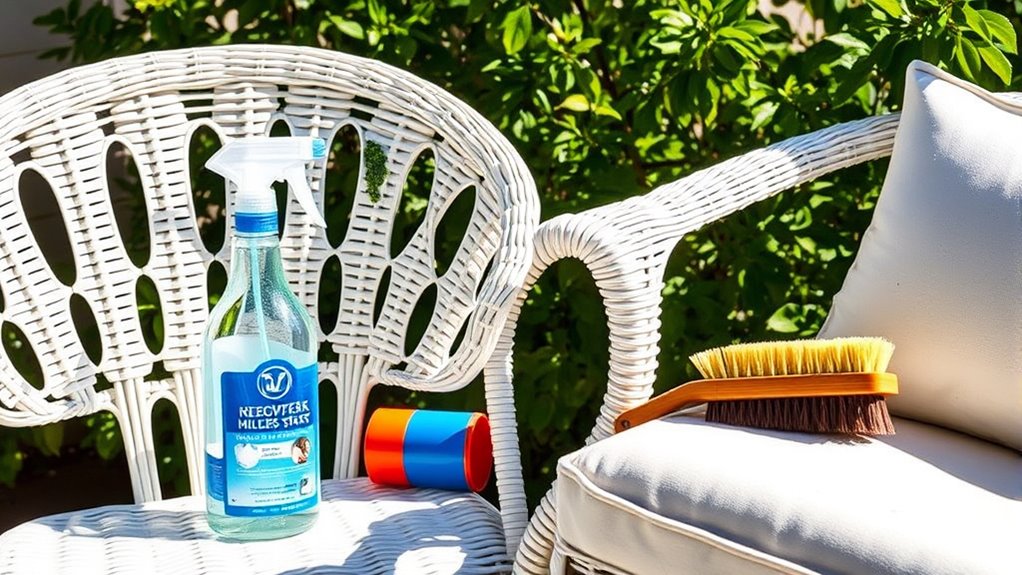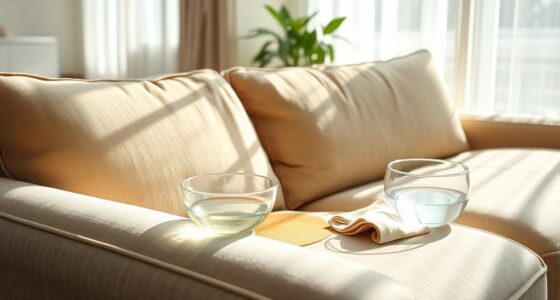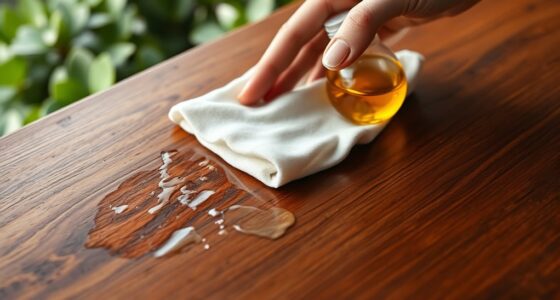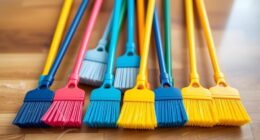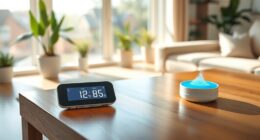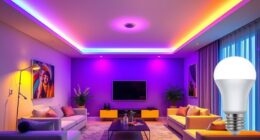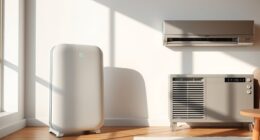To get rid of mildew stains on outdoor furniture, start by brushing off loose dirt and washing any removable cushion covers. Use a solution of 1/4 cup mild dish soap mixed with a gallon of warm water for cleaning. For stubborn stains, a 10:1 bleach solution can work marvelously, but rinse thoroughly. After cleaning, let the furniture air dry in sunlight to prevent mildew from returning. There are even more effective strategies and preventive measures you can learn about.
Key Takeaways
- Brush off loose dirt and debris, then remove and wash cushion covers before cleaning mildew stains.
- Use a 50/50 vinegar and water solution or mild dish soap mixed with warm water for cleaning.
- For stubborn stains, apply a 10:1 water to bleach solution, rinsing thoroughly afterward.
- Air dry furniture in sunlight to prevent future mildew growth and ensure complete drying.
- Store cushions indoors during off-seasons and use moisture-resistant fabrics to prevent mildew buildup.
Understanding Mildew and Its Impact on Outdoor Furniture
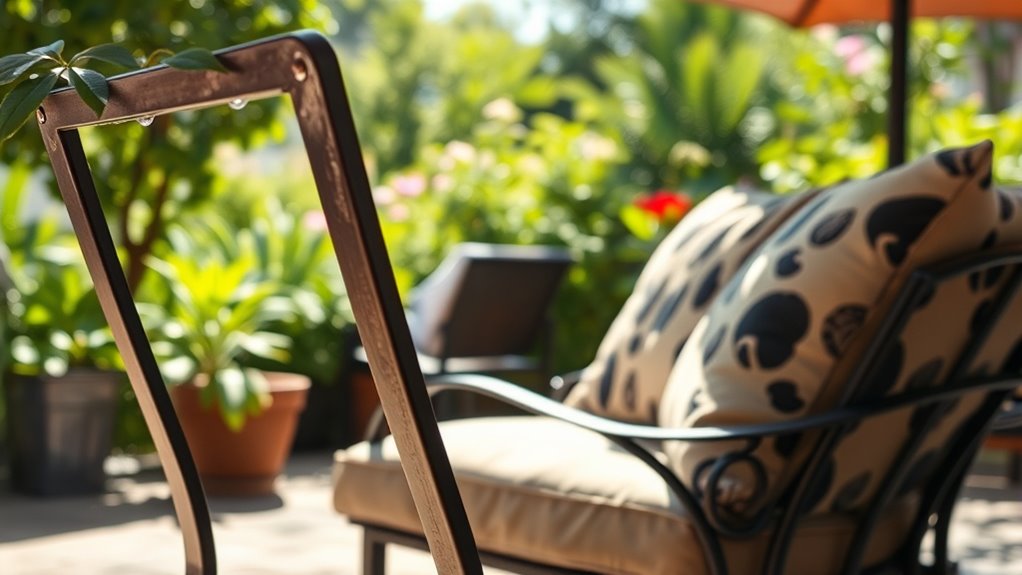
Mildew, a stubborn type of mold, can wreak havoc on your outdoor furniture if left unchecked. It thrives in damp environments, especially on organic materials like wood, wicker, and cotton. This mold forms quickly in moist conditions, damaging the quality and lifespan of your furniture. While mildew primarily affects the surface, it can cause discoloration and unpleasant odors, reducing your furniture’s aesthetic appeal. Mildew-resistant furnishings have been developed by modern manufacturers to combat this issue effectively. Wood and wicker require regular cleaning to prevent mildew, while synthetic materials are less susceptible but still need maintenance. Fabric cushions and umbrellas are particularly vulnerable due to exposure to the elements. Regular inspection and maintenance are essential to keep mildew at bay and maintain your outdoor space’s beauty and safety.
Essential Preparation for Cleaning Mildew Stains
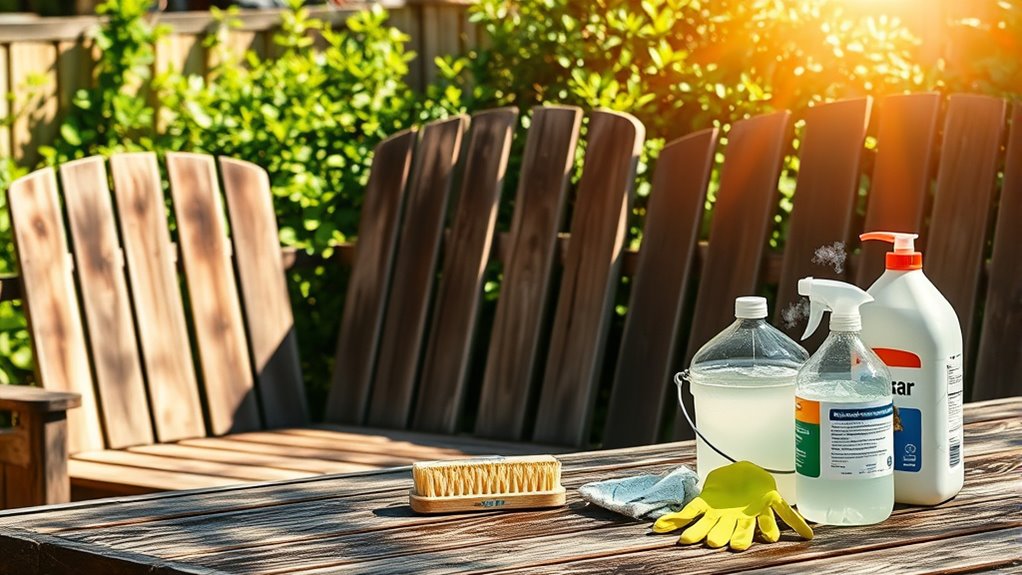
To tackle mildew stains effectively, proper preparation is key. Start by brushing off any loose dirt and debris from your outdoor furniture.
If your cushions have removable covers, take them off and wash them in the washing machine.
Next, choose your cleaning solution wisely; mix white vinegar for a natural approach or bleach for severe mildew on colorfast fabrics, always in a well-ventilated area. Check the fabric care tags to verify your chosen method is safe. Remember, avoid mixing bleach with ammonia. Additionally, ensure to check crevices and undersides of cushions for early signs of mildew before starting the cleaning process.
Finally, prioritize safety by wearing gloves and a mask, especially when dealing with severe mildew, and make sure everything is completely dry after cleaning. This groundwork sets you up for success against those stubborn stains!
Effective Cleaning Methods for Traditional Fabrics
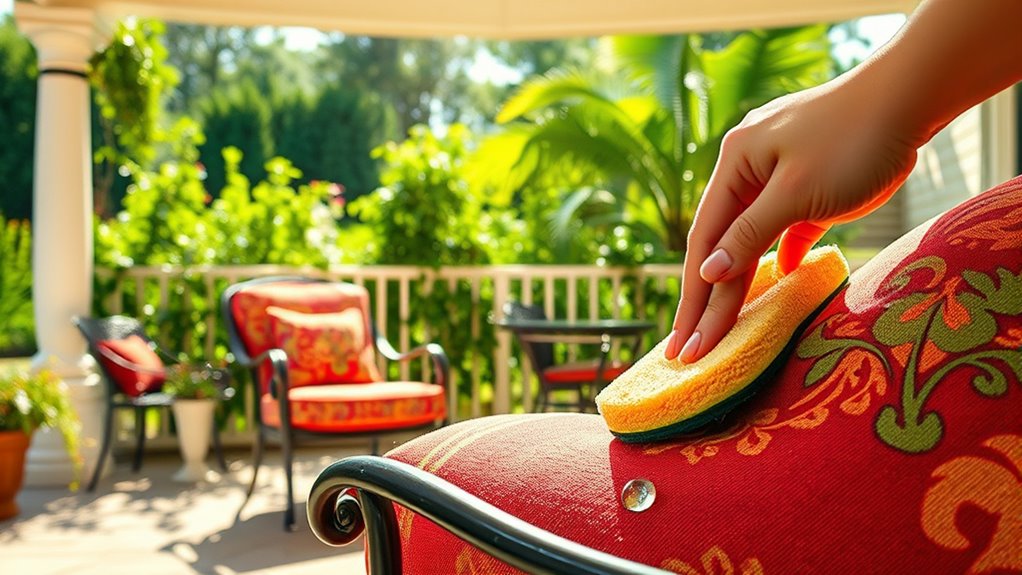
When tackling mildew stains on traditional fabrics, it’s crucial to choose the right cleaning methods to guarantee effective results without damaging the material.
Start by brushing off any loose mold with a dry brush before wetting the fabric.
For general cleaning, mix 1/4 cup of mild dish soap with a gallon of warm water. Regular maintenance will help extend the life of your outdoor fabrics and prevent mildew stains from becoming a recurring issue.
For stubborn stains, use a bleach solution with a 10:1 water to bleach ratio, applying it gently with a soft-bristled brush.
After treating the fabric, rinse thoroughly with clean water to remove residue.
Finally, allow the fabric to air dry completely in a well-ventilated area to prevent further mildew growth.
Regular maintenance will help keep your outdoor furniture looking fresh and mildew-free.
Eco-Friendly Alternatives for Mildew Removal
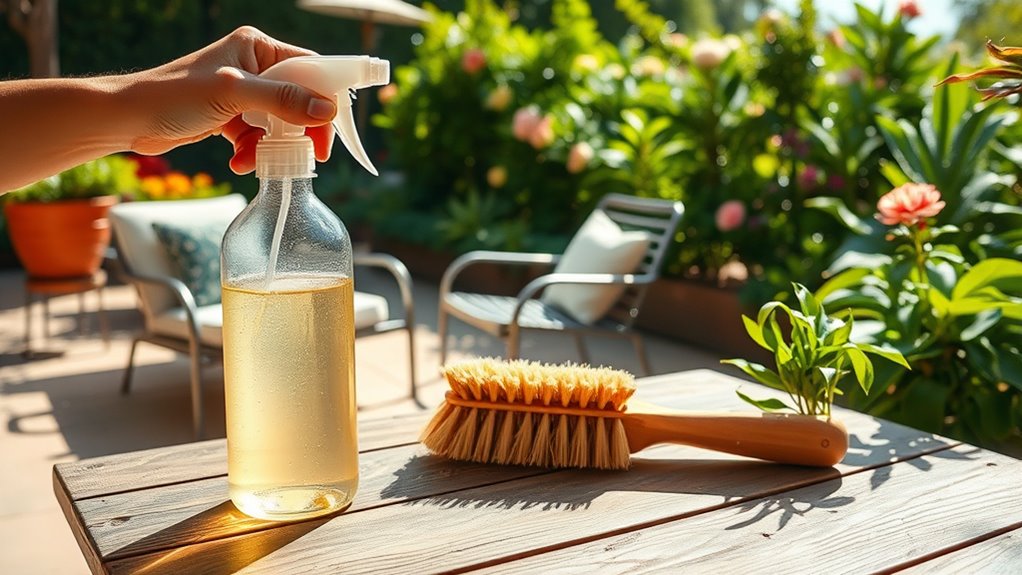
If you’re looking for effective and environmentally friendly ways to tackle mildew stains on outdoor furniture, several natural alternatives can help. A simple 50/50 vinegar and water solution is great for most outdoor fabrics. Additionally, be mindful that mildew thrives on moist surfaces, so it’s essential to keep your furniture dry. You can also create a paste using baking soda and water to gently scrub away stains. Letting your furniture air-dry in sunlight prevents future mildew growth. For a no-scrub option, consider using products like Wet & Forget, which harness natural elements for cleaning. Mold*Off is another eco-friendly choice that effectively removes mildew without bleach. Remember to regularly clean your furniture and store cushions in a dry place during off-seasons to prevent mildew buildup. Choosing moisture-resistant fabrics can also make a difference.
Specific Techniques for Different Furniture Materials

Different materials require specific techniques for effectively removing mildew stains from outdoor furniture.
For wood, you can dilute bleach in water or mix lemon juice with salt for scrubbing deeper stains. Regular cleaning is essential to prevent mildew from forming on wood surfaces.
Plastic furniture benefits from a gentle cleaner like Branch Basics or a baking soda solution.
For metal, dust first, then use the same all-purpose cleaner, rinsing with a hose afterward.
If your furniture has fabric covers, add bleach to the wash or spray a vinegar solution directly on stains.
For wicker, a mild soap solution or baking soda paste works well.
Regular inspections and maintenance are key to preventing mildew from returning, regardless of your furniture type.
Preventive Measures to Avoid Mildew Growth
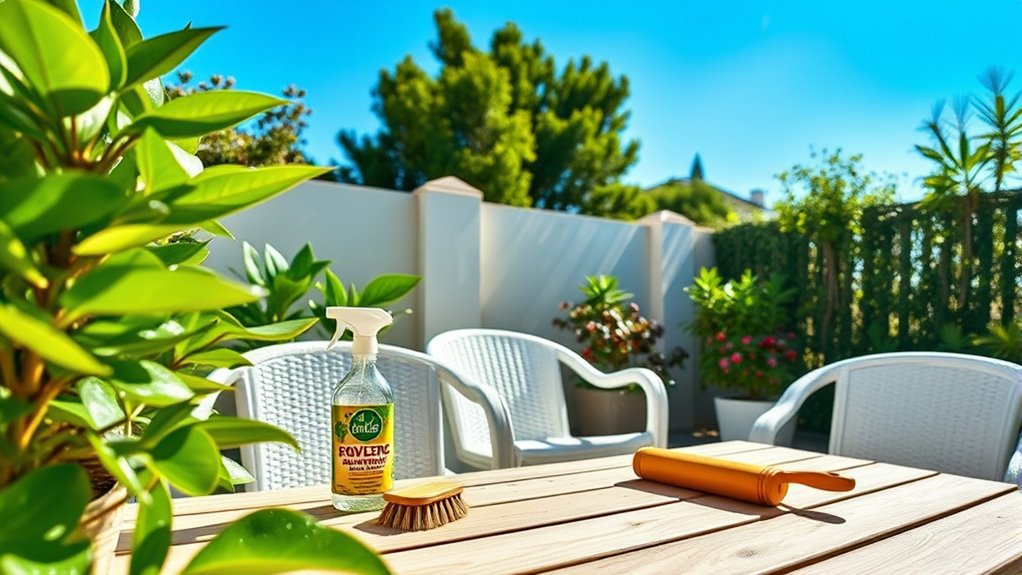
To effectively prevent mildew growth on your outdoor furniture, it’s essential to address the key factors contributing to its development.
First, choose fabrics like acrylic or olefin that resist moisture and mildew. Regularly inspect and clean your furniture to remove dust, pollen, and dead skin cells, which can feed mildew. Additionally, maintaining adequate airflow around your furniture is crucial to prevent mold growth.
Store cushions and pillows indoors during wet weather, and make certain furniture is kept in dry, well-ventilated areas. Position your furniture to avoid standing water and improve airflow by trimming nearby vegetation.
Using breathable storage covers can also help maintain a dry environment. By taking these preventive measures, you’ll considerably reduce the risk of mildew growth and keep your outdoor furniture looking its best.
Regular Maintenance Tips for Outdoor Furniture
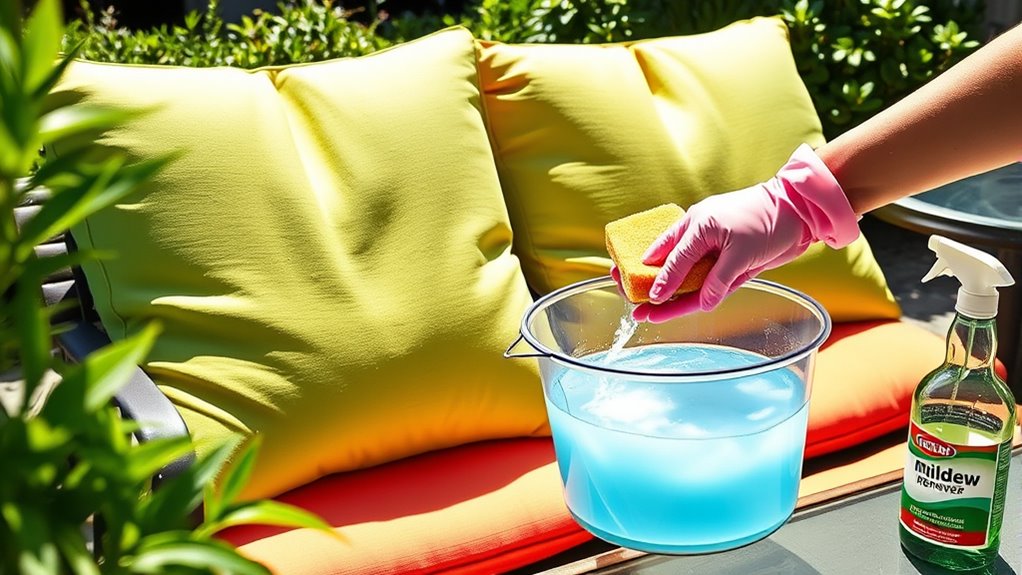
Regular maintenance is essential for keeping your outdoor furniture looking great and extending its lifespan. Clean your furniture at least once a month with a mild soap and water solution to prevent dirt buildup. For wood, scrub with a soft-bristled brush along the grain and apply protective sealants to avoid rotting. Proper installation of furniture items, much like wood stoves, can enhance their durability and overall safety. Rattan needs gentle cleaning and should be kept out of direct sunlight. Metal furniture benefits from rust-resistant paint, while plastic should be stored away from sunlight to prevent fading. Regular cleaning helps ensure that mildew does not take hold on your furniture. Additionally, using smart home devices can help monitor outdoor conditions and remind you when it’s time for maintenance. Having a reliable system can provide real-time monitoring of environmental factors that may contribute to mildew growth. Always check for nicks or scratches and repair them promptly. Implementing proper cleaning techniques can also prevent the buildup of mildew and ensure longevity. Use furniture covers when not in use, and store items in a dry place during harsh weather. These simple steps will help maintain your outdoor furniture’s beauty and durability.
When to Seek Professional Help for Mildew Issues
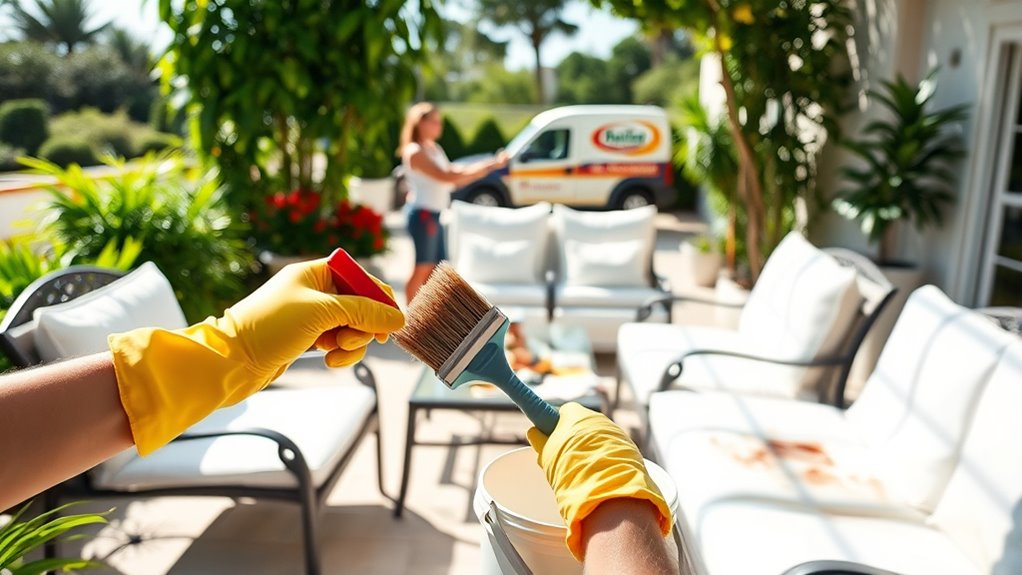
When should you consider calling in the pros for mildew issues on your outdoor furniture? If you notice extensive mold covering a large area or identify hazardous types like black mold, it’s time to seek help.
Specialized materials, such as teak or complex fabrics, often require expert care, too. Don’t forget, if your DIY attempts have failed or you lack the time and resources for proper cleaning, professionals can step in.
They’ve access to commercial-grade products and experience that assures effective mold removal. Additionally, they understand mold prevention strategies, reducing the risk of future issues.
Always look for certified service providers with positive reviews to guarantee you’re making a wise choice for your furniture’s health.
Frequently Asked Questions
Can Mildew Stains Permanently Damage Outdoor Furniture?
Yes, mildew stains can permanently damage outdoor furniture if left untreated.
They not only cause unsightly discoloration but can also lead to material deterioration, especially in wood and fabric.
Over time, mildew can weaken structures, making them unsafe.
To maintain your furniture’s appearance and integrity, it’s essential to act quickly.
Regular cleaning and preventive measures can help you avoid long-term damage and keep your outdoor space looking great.
How Long Does It Take to Remove Mildew Stains?
Did you know that humidity levels can increase mildew growth by up to 80%?
When it comes to removing mildew stains, the time varies based on factors like severity and materials. For instance, bleach solutions typically soak for 10-30 minutes, while vinegar needs about 15 minutes.
If you’re using ammonia, give it up to an hour. Staying on top of regular cleaning can greatly cut down the time you spend battling those stubborn stains.
Are There Specific Weather Conditions That Worsen Mildew Growth?
Yes, specific weather conditions can worsen mildew growth.
High humidity levels create a perfect environment for mildew to thrive, especially in coastal or southern regions. Excessive rainfall and snow increase moisture, while overcast days reduce sunlight, hindering natural drying.
Additionally, temperature fluctuations can indirectly affect moisture levels.
To combat this, consider storing items in dry, well-ventilated areas and regularly cleaning to limit mildew’s growth potential.
Can I Use a Pressure Washer on My Outdoor Furniture?
Using a pressure washer on your outdoor furniture can feel like releasing a torrent from the sky, but it’s essential to tread carefully.
You can use it on durable materials like plastic and metal, but for wood or delicate fabrics, it’s best to lower the pressure or avoid it entirely. Always keep a safe distance and test a small area first.
Regular maintenance will keep your furniture looking fresh without the risk of damage.
What Are the Signs of Mildew Beyond Visible Stains?
Beyond visible stains, you can notice discoloration on surfaces, often appearing as dark or faded patches.
The texture may feel powdery or fluffy to the touch, signaling mildew growth. You might also detect a musty odor, which indicates dampness.
If you’re experiencing allergies or respiratory issues, it could be linked to mildew exposure.
Pay attention to these signs, as they can help you identify and address mildew before it worsens.
Conclusion
By following these tips, you can effectively tackle mildew stains and keep your outdoor furniture looking its best. Isn’t it worth a little effort to enjoy your outdoor space without the worry of unsightly mildew? Remember, regular maintenance and preventive measures will go a long way in preserving your furniture. If you ever feel overwhelmed, don’t hesitate to seek professional help. Your outdoor oasis deserves the care it needs to thrive!
